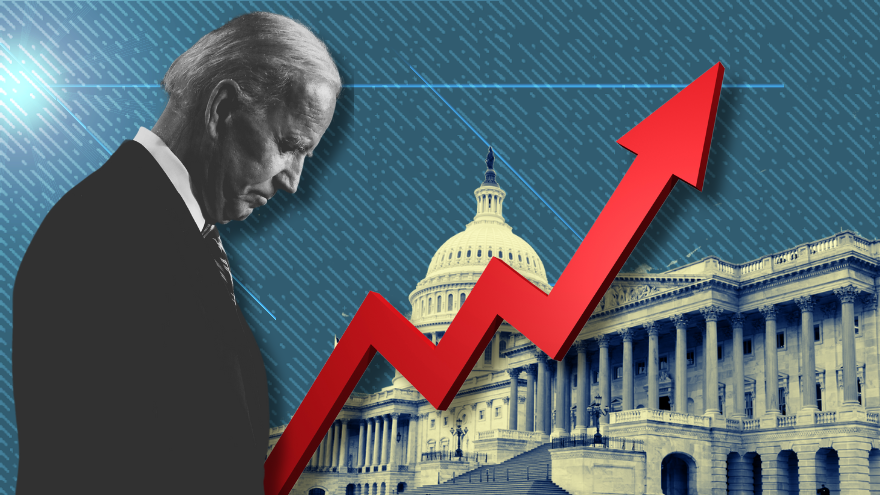While the data released by the BLS show that monthly consumer prices fell slightly — “core inflation, the Fed’s preferred inflation measure, fell to 3.6 percent annually in April, down from 3.8 percent in March,” Housingwire explained — inflation is still 3.4 percent higher compared to April 2023 — 37 months in a row above the Federal Reserve’s target of 2 percent. This metric still does not capture the full impact that rising prices, over time, are having on Americans. Year-over-year inflation numbers only do a 12-month look back. Inflation has been historically high since March of 2021. How high? The Inflation Rate Consumers Feel When Spending Since President Joe Biden was sworn into office, U.S. inflation has reached the grim milestone of 20 percent, according to Consumer Price Index (CPI) data being ignored by major publications, government officials, and analysts. (For perspective, the inflation rate was just 1.4 percent when Biden took office and prices had only risen about 6.7 percent during the four years before he assumed the presidency). Grocery prices have risen by more than 30 percent. Gas prices reached historic highs in 2022, and have since fallen slightly. Compared to April 2020, drivers are still paying roughly double to fill up their tanks. Costs for housing, medical care, food, clothing, and transportation have all soared over the past three-and-a-half years. According to the BLS, the purchasing power of a dollar in 2024 is only about 82 percent of the purchasing power of a dollar in 2020. Americans now need $1,222 for what would have cost just $1,000 four years ago. The Blame Game As should be expected during a heated election season, Republicans have been quick to place all the blame for America’s dismal inflation numbers with Biden.The latest inflation report from the U.S. Bureau of Labor Statistics (BLS) is being parsed by analysts and journalists who are largely in sync on portraying a common theme: “inflation has slowed.”
More broadly, Americans now need an extra $11,434 to maintain the standard of living they enjoyed in 2021.Loading...
However, GOP lawmakers also took actions that contributed to skyrocketing prices. One of the largest drivers of upward inflationary pressures is excessive government spending, which Congress warned about in its own paper. A 2021 report from the U.S. Congress Joint Economic Committee cautioned, “Lawmakers should also be aware of the additional risks that swelling government spending poses to American families. The most pressing risk today is rising inflation.” The report also states that action by the Fed “may not be effective if extraordinary spending patterns continue.” While congressional Republicans are pinning America’s economic crisis entirely on the Biden administration, they do so while ignoring their party’s voting record, which evidences their own culpability through passing some of the largest spending packages in history. CARES Act (Coronavirus Aid, Relief, and Economic Security Act) In March 2020, this $2.2 trillion economic stimulus bill was designed to provide relief to individuals, businesses, and healthcare providers affected by the response to the COVID-19 pandemic. The federal government enacted a “15 days to slow the spread” policy, while state and local governments piggybacked on that guidance to force far more restrictive measures on their populations. Despite the $2 trillion price tag, the legislation passed the House by a vote of 419 - 6, with eight abstentions. In total, 189 Republicans voted in favor of the bill, while just two voted “Nay” and six declined to vote. In the Senate, the legislation passed 96 - 0, with four senators not voting — Sens. Mike Lee (R-Utah), Rand Paul (R-Ky.), Mitt Romney (R-Utah), and John Thune (R-S.D.). Consolidated Appropriations Act, 2021 This legislation was a $2.3 trillion spending bill, spanning 2,126 pages, that combined $900 billion in Covid relief funds with $1.4 trillion in regular government funding. The bill was signed into law by Biden in December 2020. The legislation passed in the House by a 359 - 53 vote, with 17 abstentions. By party affiliation, 128 Republicans voted to approve the bill, while 50 opposed and 17 did not vote. Democrats supported the bill 230 - 2 with no abstentions. In the Senate, the measure passed 92 - 6, with two abstentions. Only eight Republicans voted against the bill or did not vote.Loading...
Dissenting Opinion
The loudest voice offering opposition to excessive federal government spending is Rep. Thomas Massie (R-Ky.), who blames his colleagues for contributing to the rise in inflation.
“They’re trying to put all the blame on Joe Biden, when in fact the blame belongs on Congress under both Biden and Trump,” Massie told McClatchy during a 2022 interview.
The outspoken congressman, who often bucks members of his own party, said that rising inflation validates his position on spending reforms.
“Now I have Republicans coming up to me in the House and say, ‘I should’ve stood with you then. You were right,’” he said. “I prefer to be right in the long run than be right in the moment.” Soft Landing Expectations Amid the April inflation data, economists have again revised estimated timetables for interest rate cuts, projecting the Fed potentially easing rates around late Q3 or Q4, rather than summer, as previously projected. “While the inflation data are a step in the right direction, it is one report. We retain our call for the first cut in December,” said Stephen Juneau, economist at Bank of America. Addressing overall market expectations, he said, “Market pricing thinks a cut in September and two cuts this year is very likely. We think inflation data will have to slow much more or the labor market data needs to weaken to really bring a September cut into play.”

